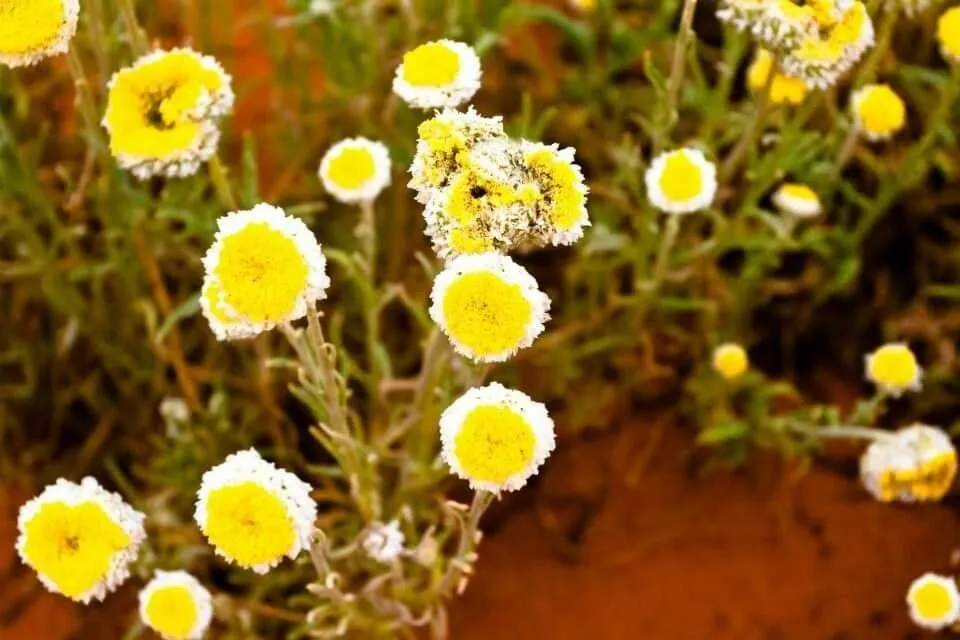
Author: F.Muell. & Sond.
Bibliography: Linnaea 25: 494 (1853)
Year: 1853
Status: accepted
Rank: species
Genus: Polycalymma
Vegetable: False
Observations: Australia
The poached egg daisy, scientifically known as Polycalymma stuartii, is a remarkable flowering plant highly regarded for its unique appearance and ecological importance. First described in 1853 by esteemed botanists F. Mueller and A. Sonder in the journal Linnaea, this plant has captivated botanists and gardeners alike with its distinctively vibrant blooms.
Native to Australia, Polycalymma stuartii thrives in this region’s varied landscapes and climatic conditions. It is a member of the Asteraceae family, a diverse group known for its composite flowers, which include many well-loved garden plants such as daisies, sunflowers, and asters. The poached egg daisy is particularly striking, boasting bright yellow and white blooms that resemble a perfectly cooked poached egg, hence its common name.
This charming annual plant typically grows to a modest height, making it an excellent addition to rock gardens and borders where it provides a splash of color without overwhelming other plants. The flowers are not only attractive to humans but also serve as a vital nectar source for a variety of pollinators, including bees and butterflies, thus playing an important role in supporting local biodiversity.
The poached egg daisy is appreciated for its resilience and adaptability, capable of thriving in both sandy and loamy soils with good drainage. It prefers full sun to partial shade and requires minimal maintenance once established, making it a favorite among gardeners seeking low-maintenance yet visually appealing plants. Its drought tolerance further enhances its suitability for Australian gardens where water conservation is crucial.
In addition to its horticultural appeal, Polycalymma stuartii has piqued the interest of researchers studying native Australian flora. Its ability to prosper in challenging environmental conditions offers insights into the evolutionary adaptations of plants in arid regions.
Cultivating the poached egg daisy can bring a touch of the Australian landscape to gardens around the world, offering a beautiful and ecologically beneficial flowering plant. Whether admired for its ornamental value or its ecological contributions, Polycalymma stuartii undeniably stands out as a remarkable representative of the rich botanical heritage of Australia.
En: Poached Egg Daisy
Taken Jul 21, 2022 by Michal Svit (cc-by-sa)
© copyright of the Board of Trustees of the Royal Botanic Gardens, Kew.
Family: Myrtaceae Author: (F.Muell.) K.D.Hill & L.A.S.Johnson Bibliography: Telopea 6: 402 (1995) Year: 1995 Status:…
Family: Rubiaceae Author: Pierre ex A.Froehner Bibliography: Notizbl. Bot. Gart. Berlin-Dahlem 1: 237 (1897) Year:…
Family: Sapindaceae Author: Koidz. Bibliography: J. Coll. Sci. Imp. Univ. Tokyo 32(1): 38 (1911) Year:…
Family: Asteraceae Author: A.Gray Bibliography: Pacif. Railr. Rep.: 107 (1857) Year: 1857 Status: accepted Rank:…
Family: Fabaceae Author: Medik. Bibliography: Vorles. Churpfälz. Phys.-Ökon. Ges. 2: 398 (1787) Year: 1787 Status:…
Family: Aspleniaceae Author: (Cav.) Alston Bibliography: Bull. Misc. Inform. Kew 1932: 309 (1932) Year: 1932…